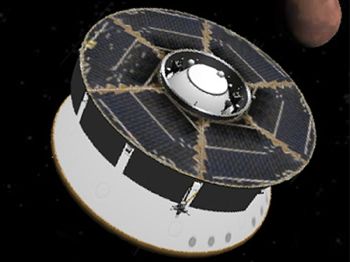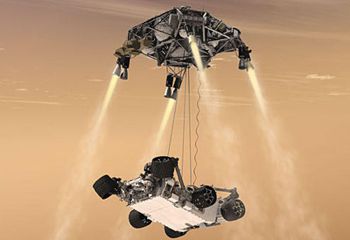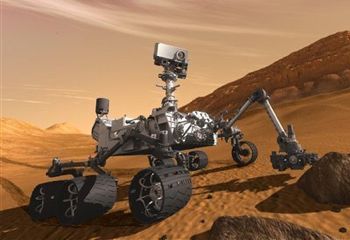
Home - Search - Browse - Alphabetic Index: 0- 1- 2- 3- 4- 5- 6- 7- 8- 9
A- B- C- D- E- F- G- H- I- J- K- L- M- N- O- P- Q- R- S- T- U- V- W- X- Y- Z
MSL
 Mars 2020 Credit: Manufacturer Image |
AKA: Mars Science Laboratory. Status: Operational 2011. First Launch: 2011-11-26. Last Launch: 2011-11-26. Number: 1 . Gross mass: 3,839 kg (8,463 lb).
Twice as long and three times as heavy as the Mars Exploration Rovers Spirit and Opportunity, the Mars Science Laboratory was to collect Martian soil and rock samples and analyze them for organic compounds and environmental conditions that could have supported microbial life now or in the past. The mission was anticipated to have a truly international flavor, with a neutron-based hydrogen detector for locating water provided by the Russian Federal Space Agency, a meteorological package provided by the Spanish Ministry of Education and Science, and a spectrometer provided by the Canadian Space Agency.
Mars Science Laboratory was intended to be the first planetary mission to use precision landing techniques, steering itself toward the Martian surface similar to the way the space shuttle controls its entry through the Earth's upper atmosphere. In this way, the spacecraft would fly to a desired location above the surface of Mars before deploying its parachute for the final landing. In the final minutes before touchdown, the spacecraft would activate its parachute and retro rockets before lowering the rover package to the surface on a tether (similar to the way a Skycrane helicopter moves a large object). This landing method would enable the rover to land in an area 20 to 40 kilometers long, about the size of a small crater or wide canyon and three to five times smaller than previous landing zones on Mars.
Mars Science Laboratory would have six wheels and cameras mounted on a mast. It was to carry a laser for vaporizing a thin layer from the surface of a rock and analyzing the elemental composition of the underlying materials. It would be able to collect rock and soil samples and distribute them to on-board test chambers for chemical analysis. Its design included a suite of scientific instruments for identifying organic compounds such as proteins, amino acids, and other acids and bases that attach themselves to carbon backbones and were essential to life. It could also identify features such as atmospheric gases associated with biological activity.
Using these tools, Mars Science Laboratory was to examine Martian rocks and soils in greater detail than ever before to determine the geologic processes that formed them; study the Martian atmosphere; and determine the distribution and circulation of water and carbon dioxide, whether frozen, liquid, or gaseous.
NASA was to select a landing site on the basis of highly detailed images sent to Earth by the Mars Reconnaissance Orbiter, in addition to data from earlier missions. The rover would carry a radioisotope power system that generated electricity from the heat of plutonium's radioactive decay. This power source would give the mission an operating lifespan on Mars' surface of a full Martian year (687 Earth days) or more while also providing significantly greater mobility and operational flexibility, enhanced science payload capability, and exploration of a much larger range of latitudes and altitudes than was possible on previous missions to Mars.
NASA NSSDC Master Catalog Description
The Mars Science Laboratory (MSL), nicknamed Curiosity, is a large rover with the objective of exploring the martian environment as a former or current habitat for life. The mission is planned to operate on Mars over at least a full martian year (687 Earth days). The rover has eight science objectives: 1) determine the nature and inventory of organic carbon compounds; 2) inventory the chemical building blocks of life; 3) identify features that may represent the effects of biological processes; 4) investigate the chemical, isotopic, and mineralogical composition of the martian surface and near-surface geological materials; 5) interpret the processes that have formed and modified rocks and soils; 6) assess long-timescale (i.e. 4-billion-year) atmospheric evolution processes; 7) determine the present state, distribution, and cycling of water and carbon dioxide; and 8) characterize the broad spectrum of surface radiation, including galactic cosmic radiation, solar proton events, and secondary neutrons.
Spacecraft and Subsystems
The rover is a six wheeled vehicle approximately 2.8 meters in length with a mass of over 750 kg. The main rover body is a warm electronics box (WEB) which houses the electronics and computer. Mounted on top of the WEB is a triangular Rover Equipment Deck, on which is mounted a mast, cameras, and other scientific equipment. A robot arm with sample collection devices and scientific instruments is also mounted on the rover. The six wheels are mounted on a rocker-bogie suspension. The two front and two rear wheels have individual steering motors. Top speed of the rover is about 4 cm per second. Power is provided by a radioisotope thermoelectric generator (RTG) which produces 125 W at the start of the mission. Thermal control is achieved by a system of tubes, with heating provided by excess heat from equipment and the RTG. The rover is equipped with four hazard avoidance cameras, two navigation cameras, and a science stereo camera mounted on the mast. There is also a descent imager designed to take images of the lading site before touchdown. Other scientific instruments on the MSL include the Sample Analysis at Mars (SAM) Instrument Suite, the MArs Hand Lens Imager (MAHLI), Alpha Particle X-Ray Spectrometer (APXS), Chemistry & Camera (ChemCam), Chemistry & Mineralogy X-Ray Diffraction/X-Ray Fluorescence Instrument (CheMin), the Radiation Assessment Detector (RAD), the Dynamic Albedo of Neutrons (DAN) experiment, the Rover Environmental Monitoring Station (REMS), and the Mars Science Laboratory Entry Descent and Landing Instrument (MEDLI).
Mission Profile
Mars Science Laboratory launched on 26 November 2011 at 15:02 UT (10:52 a.m. EST) on an Atlas V 541 into a circular Earth parking orbit. After leaving Earth orbit and completing an 8 month cruise, MSL reached Mars in August 2012. The entry phase began at an altitude of 125 km with the MSL enclosed in an aeroshell and heat shield. Following a series of S-curve manuevers to slow its descent, about three minutes before touchdown a parachute was deployed. Retrorockets were used in the final phase of the descent, ending with the rover being lowered to the surface from the descent stage on a tether. Touchdown occured at 05:32 UTC (1:32 EDT) on 6 August. After a checkout period, the rover made its first drive on 22 August. Over the nominal one martian year (687 Earth day) period, the rover will travel 5 to 20 km and collect and analyze roughly 70 rock and soil samples. The landing site in Gale Crater was chosen for its potential as a former or current habitat for life.
More at: MSL.
Family: Mars lander, Mars rover. Country: USA. Launch Vehicles: Atlas V, Atlas V 541. Projects: Mars. Launch Sites: Cape Canaveral LC41. Bibliography: 3954, 11478, 12858.
 | MSL Credit: Manufacturer Image |
 | MSL Credit: Manufacturer Image |
2011 November 26 - . 15:02 GMT - . Launch Site: Cape Canaveral. Launch Complex: Cape Canaveral LC41. Launch Pad: SLC41. LV Family: Atlas V. Launch Vehicle: Atlas V 541.
- MSL - . Mass: 3,839 kg (8,463 lb). Nation: USA. Class: Mars. Type: Mars rover. Spacecraft Bus: Mars Rovers. Spacecraft: MSL. Decay Date: 2012-08-06 . USAF Sat Cat: 37936 . COSPAR: 2011-070A. Apogee: 319 km (198 mi). Perigee: 161 km (100 mi). Inclination: 28.90 deg. Period: 89.30 min. Mars Science Laboratory; 899 kg Curiosity Rover to be landed on Mars surface in August 2012..
Back to top of page
Home - Search - Browse - Alphabetic Index: 0- 1- 2- 3- 4- 5- 6- 7- 8- 9
A- B- C- D- E- F- G- H- I- J- K- L- M- N- O- P- Q- R- S- T- U- V- W- X- Y- Z
© 1997-2019 Mark Wade - Contact
© / Conditions for Use